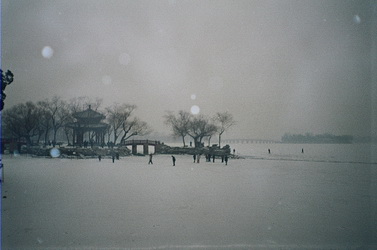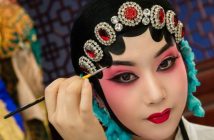
If this is your first winter in Beijing, we have bad news for you: expect tight, itchy, flaky, and possibly cracked skin. The city’s humid continental climate is influenced by a major polar air mass called the Siberian anticyclone, which brings cold, dry, and blustery winters. Radiators and other heating systems can aggravate dry skin by stripping humidity from the air. In addition, new expats may be struggling with imbalances caused by changes in diet, culture, sleep patterns, and work or school situations.

Traditional Chinese Medicine (TCM)
When Stefania Rosso relocated to the capital in 2008, she experienced a flare-up of acute dermatitis on her eyebrows, chin, and scalp. Though she had had the condition in her native Italy, it was compounded by all-over dry skin and mild eczema on her hand and leg.
After a frustrating regimen of cortisone creams and scalp lotions, Rosso decided to see a traditional Chinese medicine (TCM) doctor. “I liked the idea of TCM since I was living in China. It [saw the patient]as a whole, not only the problem,” she writes from Ningbo, where she now lives.
At the initial consultation, Rosso filled out a detailed form with various questions about her health, then got her pulse and tongue checked. The doctor prescribed a herbal formula called buzhong yiqi (补中益气) containing ginseng and astragalus, a herb with antibacterial, antioxidant, and anti-inflammatory properties. The name of the tonic translates roughly to “tonify the middle and augment the qi.” Rosso also started using a cheap body lotion called Biaoting (标婷), which could be found in most Chinese pharmacies.
She also took up “dry brushing,” a practice in which a brush with firm, natural bristles is gently dragged over bare skin in long, sweeping motions before showering. The strokes start at the feet and always follow the direction of the heart. Dry brushing is designed to stimulate the lymphatic system and exfoliate dead skin. Though proponents claim it also reduces cellulite and eliminates toxins, there is no scientific evidence to back this up. Nevertheless, Rosso started to see improvement in her skin after using these combined measures.
In TCM, dry skin is usually attributed to a deficiency in yin, one of two essential forces that makes up qi or life energy along with yang. Any imbalance in yin or yang can result in adverse health effects; TCM aims to restore the balance of these two forces.
“Think about a natural environment with [yin]imbalance: the desert,” says Chinese medicine expert and Straight Bamboo founder Alex Tan. “Environments like Beijing are cold and dry in winter. Think about Tibet or Mongolia or Scandinavia. [Natives of these places] generally eat more meat, fatty meats, dairy, porridge, root vegetables, soups, and stews. We should adjust our diets to be more yin-nourishing and with age, we should temper our schedules to be more yin-building.”
In practical terms, yin-building measures may include TCM treatments like acupuncture, guasha (scraping), cupping, or herbal prescriptions depending on the nature and severity of the problem. The biggest yin builder is sleep, so it is crucial to assess the timing, duration, and quality of a patient’s rest cycle. Treating children for dry skin follows a similar process, except that that children’s skin issues are much more likely to be of digestive origin. In this case, diet and rest are key.
“One of the great yin builders in TCM is to have soup, porridge, or stews with your meal,” says Tan. “Bone broth, seaweed or mushroom are best.” That said, yin foods can be difficult to digest and overindulging in them can create “dampness” in the body – in other words, an accumulation of fluids that can manifest as excessive mucus, phlegm, or congestion.
To counteract winter ailments, Tan recommends getting more sleep, going to bed early and rising later, showering less frequently, reflecting more than producing, taking hot foot baths at night, and dressing like the locals with a pair of qiuku (thermal pants) at all times. “Warm feet and a cool head is the key to happy digestion, strong qi, and strong blood,” he says.

Ayurvedic Medicine
According to Ayurveda, an ancient holistic health system from India, the key to skin type lies in the doshas – vata (space and air), pitta (fire and water), and kapha (water and earth) – or life energies within each person.
“Since everyone has a different balance of elements, we naturally have a different balance of doshas too,” explains Irina Glushkova, an Ayurvedic consultant who makes her own line of customized, natural skincare products. “Vata dosha produces dry skin. The doshas also have a yearly cycle, which we experience as the seasons.”
“Beijing this time of the year, from the beginning of November until the end of February, is under vata dosha – cool, dry, windy. This climate brings out similar types of changes in all of us. We develop dry skin, dry lips and feet, dandruff and other dry skin problems.”
All skin conditions – including acne, eczema and psoriasis – are caused by accumulated ama (toxins). In Ayurvedic medicine, the first step is to detoxify the body and balance one’s diet. However, lasting change can only result from making changes to one’s lifestyle.
“The Ayurvedic concept is that health and disease are holistic – that is, whatever happens in one part of the body happens to the whole body,” says Glushkova. “Any physical or psychological symptom of imbalance indicates an imbalance in the body-mind unit.”
In the winter, she recommends massaging sesame oil into the hair and body before going to bed. This can also help children settle down and sleep better. Olive, almond, peanut, castor, and avocado oils are also suitable for winter.
Glushkova cautions against using coconut oil because of its cooling nature. In Ayurveda, it is commonly used to treat symptoms associated with pitta imbalance such as inflammation and high blood pressure. “If you love coconut oil, it is better to mix it with other oils during the winter before applying it to your body or hair. Add a selected essential oil to balance the doshas and nourish the skin. Essential oils that are good for dry skin include sandalwood, cardamom, nutmeg, jasmine, rose, geranium, neroli, and vanilla.”
Glushkova also warns against using essential oils on children without first consulting a doctor. Not everyone can apply pure plant oils directly to the face, as these can be very heavy. Instead, she suggests a balanced face cream made with hydrating substances like macadamia oil, avocado oil, amaranth oil, beeswax, vegetable glycerin, ceramides, lecithin, or phystosterols.
Glushkova started making her own skincare products after changing her lifestyle through Ayurveda; she became a vegetarian, and started to learn about the chemicals and other harsh ingredients in beauty and household products.
Because her products are made fresh and do not contain preservatives, they must be kept in the fridge. Glushkova says that her ingredients – including organic oils, essential oils, beeswax, flower wax, vitamins, natural extracts, and antioxidants – are 100 percent natural and sourced from all over the world. Her product line encompasses moisturizers, serums, eye and face creams, body lotions, shampoos, conditioners, hair and face masks, and hand and foot creams.
Western Medicine
Irina Glushkova is not alone in making her own skin products. When San Francisco native Aimee Ng moved to Beijing over 11 years ago, she developed severe dry skin that cracked and bled. The condition was caused by the combination of dry winters, indoor heating, and frequent hand-washing required by her former job as a preschool teacher.
In addition, her three children – now 4, 2 and a half, and 1 – had had sensitive skin since birth, developing red rashes in response to even minute amounts of detergent residue on their clothing. Her older son started to experience particularly dry skin in the winter and sometimes scratched at it until he bled and developed scabs.
Ng started to make her own lotion bars based on a recipe from a blog called One Good Thing. “I wanted to have products that I felt good about using on my kids – without any harmful chemicals that might get absorbed into their systems and that I wouldn’t mind them touching or licking off their hands – without paying for expensive commercial natural products,” she says.
After seeing a different recipe on the same blog, she tweaked the formula to be creamier and easier to spread. Her family uses this particular recipe – a 1:1:1 ratio of beeswax, coconut oil, and extra virgin olive oil – to this day.
“In warmer weather, it is very easy to scoop out with your fingers. When it is colder, it hardens up a bit, but I’ve found that if you just use the back of your nails to scrape the surface of it a few times, you can rub it between your palms for a few seconds and that heats it up enough to make it easy to rub on.”
Ng buys the coconut oil and extra virgin olive oil from Costco whenever she is in the US, though she says the ingredients are easy to find in Beijing. She also used to bring back the beeswax from overseas until her mother found it being sold for much cheaper on Taobao. Though it seemed less refined than the beeswax she used to get in the US, the cream turned out just fine with a light, pleasant scent.
Choosing a good moisturizer can be tricky, especially for children’s sensitive skin. “My rule of thumb is [a white moisturizer]without fragrance and that is hypoallergenic,” says Dr. Jayne Zierman, head of the pediatrics department at Oasis International Hospital.
“Other factors to consider are the form of the moisturizer and the frequency of application. Lotions are mostly water-based and hence good for summertime while creams and ointments are good for winter and especially dry skin. Moisturizer should be used once per day to maintain good hydration, then increased in frequency if the skin condition gets worse.”
Though there is still a lot of debate over what causes chronic conditions like eczema and psoriasis, there appears to be a strong genetic component to these diseases. In 2006, geneticist Irwin McLean and pediatric dermatologist Dr. Alan Irvine discovered that individuals lacking a protein called filaggrin were at a higher risk of developing eczema, rhinitis, and asthma.
It is important to identify the factors that trigger or worsen chronic skin conditions and take measures to avoid the triggers. “Eczema and psoriasis are lifelong conditions without cures, but their symptoms can be controlled and managed,” says Dr. Ziermann.
Though anecdotal evidence shows that shower filters may alleviate hair and skin dryness, she is cautious about recommending them. “There are studies that show they are quite beneficial for [a segment of the]population, but they are still under investigation,” says Dr. Ziermann.
However, there are other reasons to consider installing shower filters. Sources like the US-based Environmental Protection Agency (EPA) and the American Journal of Public Health report serious health risks – including a higher risk of cancer – from inhaling or absorbing chlorine and its byproducts through the skin from shower water.
See the sidebar for useful tips on avoiding dry skin this winter.
7 Ways to Avoid Dry Skin
1. Take shorter, warm showers. Though it may be tempting to crank up the water temperature in the morning, hot water strips the skin of its natural oil barrier. Limit showers and baths to 5 to 10 minutes, then pat dry and moisturize.
2. Use sunscreen. Though UV rays are strongest in the summer, that does not mean you should skimp on sun protection during the colder months. Cover up, use a broad spectrum SPF 30 sunscreen, dress in layers, and use a lip balm with SPF 15 sunscreen.
3.Moisturize right. The simpler the moisturizer, the better. Good choices include petroleum jelly, mineral oil, and unscented body lotion. Those who like rich moisturizers can choose a product containing shea butter, ceramides, stearic acid, or glycerin. Moisturizer is best applied after a shower, when the pores are most open and moisture is most effectively trapped. Remember to moisturize your hands every time you wash them.
4. Buy a humidifier. These little home appliances add moisture back into the air – a must-have for any heated environment. Buy one for each room if possible. Test humidity levels with a device called a hygrometer; aim for at least 50 percent. Cheap hygrometers are available on Taobao for RMB 15-20; search for 湿度计 (shīdù jì).
5. Avoid harsh soaps and toners. Use gentle facial cleansers, shower gels, and soaps with added moisturizers, oils, or fats. Avoid products with deodorants, antibacterial detergents, fragrance, and alcohol.
6. Wear breathable fabrics. Choose natural fibers like cotton and silk. Wool, although natural and warming, can irritate even normal skin; if you wear a wool sweater, layer a gentler fabric underneath.
7. Drink lots of water. Do not forget to hydrate from the inside out. Do as the locals do and drink hot water (热水, rèshuǐ), a practice rooted in traditional Chinese medicine. Too much cold accumulation in the body can weaken the immune system and cause poor circulation, digestion issues, cramps, and abdominal pain.
Sources: WebMD, Mayo Clinic, Organic Olivia
Resources
Oasis International Hospital
Pediatrics Department Chief Dr. Jayne Ziermann speaks English, Tagalog, and German. Mon-Sat 8.30am-5.30pm (some clinics open from 8.30am-12.30pm), daily 24hrs emergency care. 9 Jiuxianqiao Beilu, Chaoyang District (400 UR OASIS) www.oasishealth.cn
朝阳区酒仙桥北路9号
Straight Bamboo
To learn more about TCM practitioner Alex Tan and Straight Bamboo, visit straightbamboo.com.
Vedic Life
For a free Ayurvedic consultation, contact Irina Glushkova at 139 1180 9671 or add “Irina GL” on WeChat. As of print time, Vedic Life had a website in the works:
www.vediclifeshop.com.
A Step-by-Step Guide to Dry Brushing
www.mindbodygreen.com/0-12675/a-step-by-step-guide-to-dry-skin-brushing.html
One Good Thing
The blog posts that Aimee Ng based her homemade moisturizing salve on:
http://www.onegoodthingbyjillee.com/2012/04/make-your-own-lotion-bars.html
http://www.onegoodthingbyjillee.com/2013/05/diy-all-purpose-healing-salve.html
Photos: courtesy of Wikimedia Commons, Alex Tan, and Irina Glushkova
This article originally appeared on page 22-25 of the beijingkids December 2015 issue. Click here to read the issue for free on Issuu.com. To find out how you can get your own copy, email distribution@truerun.com




